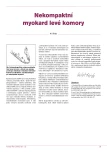Role of two-dimensional echocardiography in diagnostics of hypertrophic cardiomyopathy
Authors:
J. Veselka
Authors‘ workplace:
2. LF UK a FN V Motole, Praha
; Kardiologická klinika
Published in:
Kardiol Rev Int Med 2006, 8(1-2): 52-55
Category:
Editorial
Overview
Echocardiography is essential for HCM diagnostics. Except for magnetic resonance imaging (MRI), all the other examinations are rather supporting. Diagnosis of HCM is usually based on left ventricle (LV) hypertrophy mainly in interventricular septum (IVS) and front wall. HCM diagnostics also focuses on reduced LV with high ejection fraction, Doppler signs of impaired LV diastolic function and intraventricular gradient that is found in one-fourth of patients. Another typical sign of HCM is asymmetric septal hypertrophy with maximum LV wall thickness exceeding 12 mm and with IVS/free wall ratio over 1.3. If ratio of 1.5 is applied, the examination is even more specific. It should be emphasized that echocardiographic criteria have to be related to clinical examination and that LV hypertrophy or intraventricular obstruction alone are not reasons for diagnosing HCM. In clinical practice, heart morphology is best described by echocardiography. Hopefully we can soon use cardiac MRI that is in the frame to diagnose HCM even more accurately.
Keywords:
hypertrophic cardiomyopathy – echocardiography – obstruction
Sources
1.Spirito P, Bellone P, Harris KM et al. Magnitude of left ventricular hypertrophy predicts the risk of sudden death in hypertrophic cardiomyopathy. N Engl J Med 2000; 342: 1778-1785.
2.Elliot PM. Relation between severity of left ventricular hypertrophy and prognosis in patients with hypertrophic cardiomyopathy. Lancet 2001; 357: 420-424.
3.Dimitrow PP, Dubiel JS. Echocardiographic risk factors predisposing to sudden cardiac death in hypertrophic cardiomyopathy. Heart 2005; 91: 93-94.
4.Charron P, Dubourg O, Desnos M et al. Diagnostic value of electrocardiography and echocardiography for familial hypertrophic cardiomyopathy in a genotyped adult population. Circulation 1997; 96: 214-219.
5.Forissier JF, Charron P, Tezenas du Montcel T et al. Diagnostic accuracy of a 2D left ventricle hypertrophy score for familial hypertrophic cardiomyopathy. Eur Heart J 2005; 26: 1882-1826.
6.Maron MS, Zenovich A, Casey SA et al. Significance and relation between magnitude of left ventricular hypertrophy and heart failure symptoms in hypertrophic cardiomyopathy. Am J Cardiol 2005; 95: 1329-1233.
7.Gregor P, Veselka J. Hypertrofická kardiomyopatie. In: Aschermann M (ed). Kardiologie. Praha: Galén 2004.
8.Frans EE, Nanda NC, Patel V et al. Live three-dimensional transthoracic contrast echocardiographic assessment of apical hypertrophic cardiomyopathy. Echocardiography 2005; 22: 686-689.
9.Eriksson MJ, Sonneberg B, Woo A et al. Long-term outcome in patients with apical hypertrophic cardiomyopathy. J Am Coll Cardiol 2002; 39: 638-645.
10.Matsubara K, Nakamura T, Kuribayashi T et al. Sustained cavity obliteration and apical aneurysm formation in apical hypertrophic cardiomyopathy. J Am Coll Cardiol 2003; 42: 288-95.
11.Wigle ED, Sasson Z, Henderson MA et al. Hypertrophic cardiomyopathy. The importace of the site and the extent of hypertrophy: a review. Prog Cardiovasc Dis 1985; 28: 1-83.
12.Thaman R, Gimeno JR, Murphy RT et al. Prevalence and clinical significance of systolic impairment in hypertrophic cardiomyopathy. Heart 2005; 91: 920-925.
13.Dalldorf FG, Willis PW IV. Angled aorta („sigmoid septum“) as a cause of hypertrophic subaortic stenosis. Hum Pathol 1985; 16: 457-462.
14.Lever HM, Karam RF, Currie PJ, Healy P. Hypertrophic cardiomyopathy in the elderly. Distinctions from the young based on cardiac shape. Circulation 1989; 79: 580-589.
15.Okeie K, Shimizu M, Yoshio H et al. Left ventricular systolic dysfunction dutiny exercise and dobutamine stress in patients with hypertrophic cardiomyopathy. J Am Coll Cardiol 2000; 36: 856-863.
16.Okawa M, Kitaoka H, Matsumura Y et al. Functional assessment by myocardial performance index (Tei index) correlates with plasma brain natriuretic peptide concentration in patients with hypertrophic cardiomyopathy. Circ J 2005; 69: 951-957.
17.Veselka J, Procházková Š, Duchoňová R et al. Effects of alcohol septal ablation for hypertrophic obstructive cardiomyopathy on Doppler Tei index: a midterm follow-up. Echocardiography 2005; 22: 105-110.
18.Rakowski H, Fulop J, Wigle ED. The role of echocardiography in the assessment of hypertrophic cardiomyopathy. Postgrad Med J 1986; 62: 557-561.
19.Klues HG, Roberts WC, Maron BJ. Morphologic determinants of echocardiographic patterns of mitral systolic anterior motion in obstructive hypertrophic cardiomyopathy. Circulation 1993; 87: 1570-1579.
20.Veselka J, Duchoňová R, Procházková Š et al. Alcohol septal ablation for obstructive hypertrophic cardiomyopathy: slower hemodynamic improvement and septum thickness reduction in younger patiens. Am J Cardiol 2005; 95(Suppl A): 67-68.
21.Shimizu M, Hawai K, Kokota Y, Yokoyama M. Echocardiographic assessment of right ventricular obstruction in hypertrophic cardiomyopathy. Circ J 2003; 67: 855-860.
Labels
Paediatric cardiology Internal medicine Cardiac surgery CardiologyArticle was published in
Cardiology Review

2006 Issue 1-2
Most read in this issue
- Hypertension in children and adolescents
- Diagnostic possibilities of peripheral arterial disease
- Sudden cardiac death: how to prevent it
- Non-pharmacologic therapy of arterial hypertension
